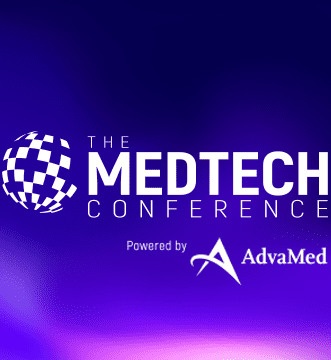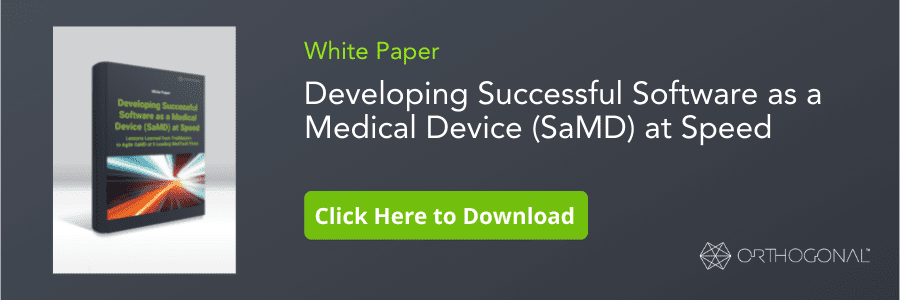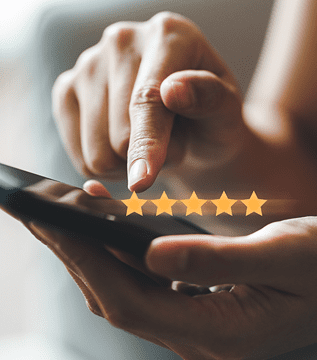
Article
The Future of MedTech: Insights from Industry Leaders
This is an edited transcript of the third and final episode of Orthogonal’s “Patient Engagement & Connected Medical Devices” podcast, featuring Bernhard Kappe, Founder and CEO of Orthogonal, Adrian Pittman, User Experience Design and Human Factors expert, currently Director of Product Design at LinkedIn (previously of Google and Orthogonal), Gia Rozells, Senior Director of User Experience Design at Becton Dickinson, and Christi Zuber, Founder and Managing Director of Aspen Labs.
You can listen to the third episode of the podcast below, or stream it wherever you find podcasts.
[simplecast-embed src=”https://patient-engagement-and-connected-medical-devices.simplecast.com/episodes/s1e3-whats-next-for-medical-devices-patient-engagement”]
Links to the series of transcripts:

Bernhard Kappe:
If there’s one thing that we all learned by watching children and adults shift school and work to a virtual remote format over the last two years, it’s that there’s a huge difference between showing up and actually engaging.
Adrian Pittman:
And just because you attend an online class, it doesn’t mean that you are actually engaging in that class, and actually learning and growing your body.
Bernhard Kappe:
In the same way there’s a huge difference between a patient properly using i.e., being compliant with or adhering to the use of a medical device at home, and a patient actively seeking to squeeze every ounce of clinical value out of that device to improve their own outcomes.
Adrian Pittman:
Increasingly, the healthcare and MedTech industries are evolving to support remote diagnosis, monitoring and treatment of health conditions by patients and their caregivers, but without the benefit of the doctor’s office, hospital or real-time supervision, this can get complicated.
Bernhard Kappe:
So how do we get patients and their caregivers, not just to use devices, but to actively engage with them in the best way possible to improve their own healthcare? And for those with chronic conditions, how do we make this happen as a regular routine that just happens without intervention by the provider or payer?
Adrian Pittman:
That’s what we’re going to be discussing in this three part series on patient engagement and connected medical devices presented by Orthogonal.
Bernhard Kappe:
I’m Bernhard Kappe, founder and CEO of Orthogonal. We’re all about improving patient outcomes faster. We mostly work in Software as a Medical Device and connected medical device systems, and we apply modern methods within the regulatory constraints to build, evolve and scale solutions faster.
Adrian Pittman:
And I’m Adrian Pitttman, user experience design and human factors expert, currently director of product design at LinkedIn, previously of Google and Orthogonal. We’d like to thank you for joining us today to listen to the third of a three part series from our recent conversations with two fantastic industry experts who shared their experiences and perspectives with us on patient engagement and connected medical devices.
In the first and second episodes, we spoke about how the pandemic impacted patient engagement and how user-centered design can improve patient outcomes. In our third and final episode of the series, we’re going to talk about what the future might hold for patient engagement as it relates to connected medical devices. We’ll cover where we see the real breakthroughs coming from in the future, and some of the challenges we’re still going to have to collectively tackle as an industry. So with that, let’s return to our conversation with Gia Rozellsand Christi Zuber.
Thinking about what’s next, where do you hope to see things go in the future? And what are some of the low hanging fruit opportunities that you see to sort of push us in the right direction?
Gia Rozells:
I hope that something Christi mentioned comes into play, which is different types of training for clinicians who are going to be working with users who are taking their healthcare into their own homes. I think that could make a huge difference and it wouldn’t be very difficult to fold that into the training that they’re already getting.
Christi Zuber:
Building on that, I’m also really excited about the opportunity to begin to design more for at-risk populations that don’t have a lot of access. I’m working with several organizations that are partnering up with a coalition for the homeless, for example. And when you think about the opportunities, if you can design things for at-risk populations, how many other opportunities are there? If you can design for people who are struggling with homelessness, and you solve those challenges, imagine how many other needs you’ve met as you’ve addressed that. Sometimes it really opens up our mind and you find the common and the uncommon. Extreme situations like that are amazing grounds for innovation, just like how taking care of people in space has been, and all the things have come from that. When we push ourselves in those kinds of ways, in the process of doing that we uncover 150 things that are fantastic for a more average part of our population. How amazing is that?
I’m really excited about the opportunities for clinicians to be a part of it. I’m really excited about beginning to use methods to engage people differently. I’m really excited about behavior change and understanding people’s lifestyles. I’m really excited about meeting people’s needs that have been unmet in the past and seeing where that leads us.
Gia Rozells:
You made me think that as we are going to be developing all these new technologies, digital, electronic, who knows what we’ll find. It’s a chance for us to explore things that we haven’t always considered in the past, like different countries, different people, people who don’t have Internet, people who are living in poverty. This is a chance to develop new things with everyone in mind, so that we can come up with more equitable solutions as we go along.
Bernhard Kappe:
And I think the same thing applies when you’re designing for emerging markets. Where some of these things we expect, like internet access, aren’t really there. Yet at the same time, in some cases, they learn to adapt technologies and do things that we aren’t doing here. If you look at mobile payments, a lot of issues revolve around the smartphone in a place where you don’t have landlines and internet connectivity. I know folks that are working on devices specifically for emerging markets, and that because they’re designing for those things and a somewhat different set of constraints does not mean that those products don’t end up being useful here. They just happen to be designed for different constraints. Maybe you can get the same thing done more elegantly for less money. Ultimately that comes back here down the line as well. It is a fascinating area. I wish more money was devoted towards that.
Gia Rozells:
Yes.
Adrian Pittman:
Totally. It’s funny, going back to something that Christi said: Accessibility, but with an additional angle of more diverse solutions. I think a lot of the options that are proposed are variations on established themes. Some of them are 50, 60 years old, they’re just digitized. And one could argue that some things are just, it’s a bicycle, there’s only so many improvements you could make on it. But the vast majority of these things are not bicycles. They never really worked for the people that they’re supposed to be helping, and iterating on them isn’t really getting us where we need to go. And so as technology becomes less expensive to experiment with, a variety of different technological superpowers become available in the design and development space. We’re seeing more exploration around that, more optionality around solutioning.
As an example, I look at Google Home, which is a product that I was using before I worked at Google. (I used it after I left Google.) What I found interesting about it was how little it required me to do to get value out of it. I just plugged it in and connected it to the Internet, two items that were easy the first time and get easier with each successive device you add because it just borrows it from everywhere else.
Apple has a similar model, and as long as I’m comfortable with the microphone being on – and it doesn’t always have to be on – it can answer all my questions. It can integrate my home. It can follow me on my mobile device. I imagine a world where my health conditions follow me everywhere too. They’re with me all the time, and I need to be able to live my life and not live my life for those conditions. I know that there are a lot of people that have chronic lifelong conditions that feel the same way. The solution should be equally seamless, and getting to a point where we can do that, I think, is really exciting.
Christi Zuber:
Here, here.
Gia Rozells:
Absolutely.
Bernhard Kappe:
I agree. There’s only one problem, right? If the microphone is on and next thing you know, Amazon is telling you that there’s some great voice lessons you can get because it was listening to your singing and thinking “oy.”
Adrian Pittman:
Well, you can’t have an advertising media financial model. Let’s agree with that.
Christi Zuber:
We can’t mix up medical with advertising.
Adrian Pittman:
Yeah those two things can’t go together at all. They’re different universes.
Well, everyone, this has been really enjoyable. Thank you so much for taking the time and we wish you guys the best and hopefully our path will cross on future conversations.
Gia Rozells:
I hope so. Thanks so much.
Christi Zuber:
Thank you. It’s been great.

Bernhard Kappe:
We’d like to thank our awesome guests for this podcast. Christi Zuber, the Founder and Managing director of Aspen Labs and Gia Rozells, Director of User Experience at Becton Dickinson. I’m Bernhard Kappe.
Adrian Pittman:
And I’m Adrian Pittman.
Bernhard Kappe:
If you enjoyed this podcast and want to hear more content like it, you can check out Orthogonal’s website at orthogonal.io. Our Insight section is regularly updated with fresh content related to connected medical device systems, Software as a Medical Device and Digital Therapeutics. You can also reach out to me at [email protected].
Adrian Pittman:
Or reach me at [email protected]. We look forward to hearing from you.
This is an edited transcript of the third and final episode of Orthogonal’s “Patient Engagement & Connected Medical Devices” podcast.
You can listen to the third episode of the podcast at the top of this page, or stream it wherever you find podcasts.
Links to the series of transcripts:
Related Posts

Article
The Future of MedTech: Insights from Industry Leaders

Article
Case Study: Capturing Quality Images for ML Algorithm

Article
Patient Engagement & UX for Bluetooth Medical Devices

Article
How Design Can Improve Ratings for Medical Device Apps